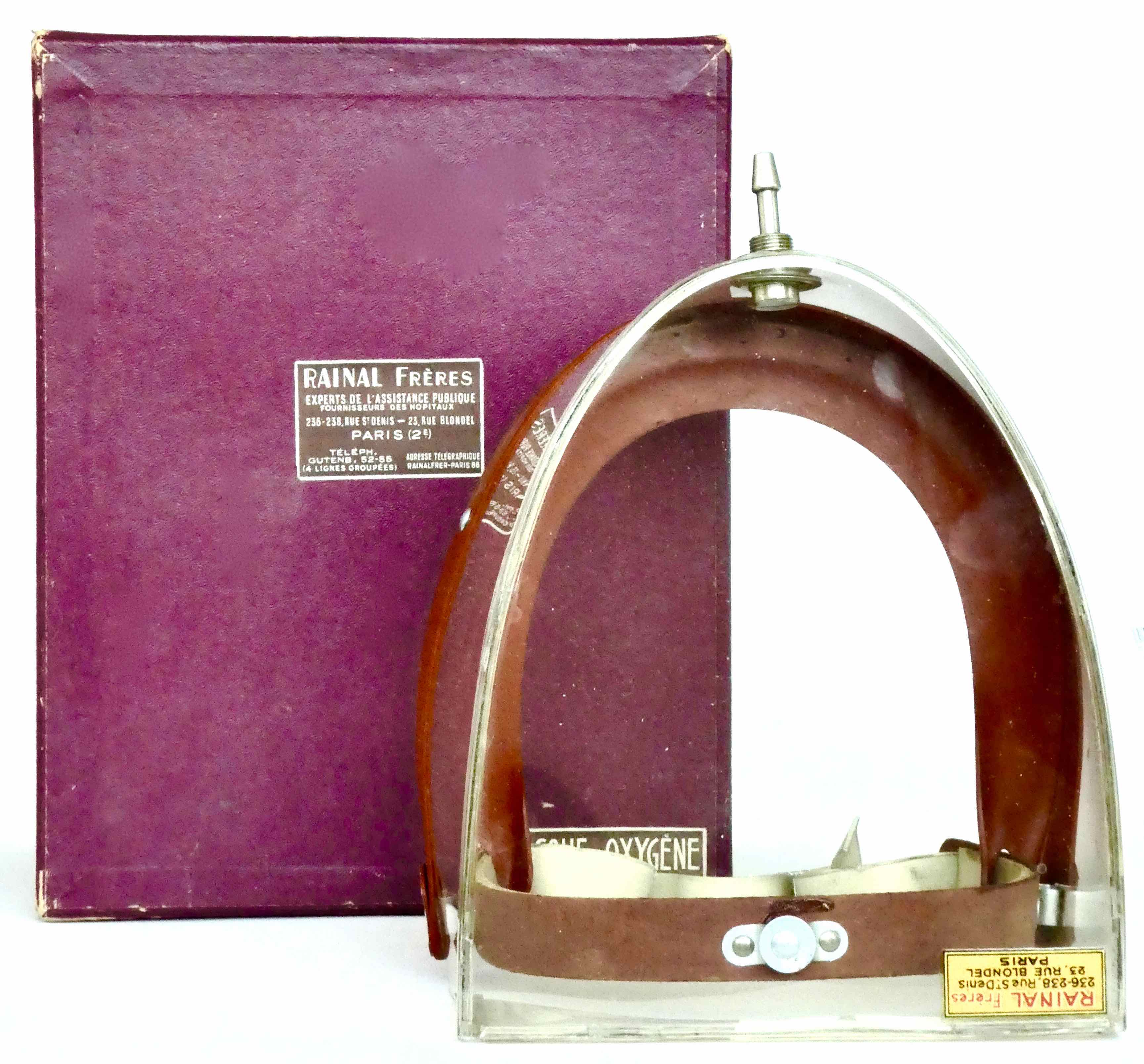 |
|
Maske, 1939
|
Léon BINET (1891-1971) took part in the Verdun fighting in 1914, and in 1917 he was called into the working group of Charles ACHARD to study the effects of combat gauze (André Cornet, Léon Binet physiologiste et médecin, in: Histoire des Sciences mèdicales , Vol. 26 n ° 4 1992 p.259-262).
He became the apostle, the prophet of the French revival, especially the use of oxygen in resuscitation. In his 1945 published book "Nouveaux aspects de la lutte contre la mort" he used the term of revivalism. The Paris pharmacist Stanislas-Alexis-Arsène LIMOUSIN (1831-1887) conceived the "Ballon d'oxygène", Edmond WEILL (1858-1924) and Joseph DUMAS even used it in childhood bronchopneumonia. ISELIN and SANDER sneered the process as "gesture rituel agonique". Maurice d'HALLUIN (1877-1947), a professor at the Faculté libre de Médecine de Lille, had invented heart massage and combined it with the supply of oxygen, which he blew directly into the trachea. With the increased supply of oxygen, the risk of poisoning - 60% gas mixture proved optimal - BINET and his assistant Madeleine BOCHET confirmed the value 1917, after they had proposed 96-98% over the years. Their experiments proved that a healthy dog can endure 2g% Hb under 2 conditions:
- the blood volume is sufficient, and,
- the animal gets OXYGEN
... 2 requirements that are realized in modern accident medicine: volume replacement by plasma expander, oxygen via the appropriate, anatomically adapted (nameless) face mask.
Modern masks
- Venturi mask, invented in 1960 by the British Edward James Moran CAMPBELL (1925-2004), named after the Italian physicist Giovanni Battista VENTURI (1746-1822).
- Hudson or MC mask, patented in 1961, named after the physician Mary CATTERALL (1922-2015).
"Masque à oxygène Binet-Bochet", Masque est fabriqué par Rainal Frères, 236-238 rue Saint Denis, Paris et 23 rue Blondol, Paris. "Le masque répond particulièrment à une thérapeutique d'urgence, en crème de crise d'étouffemnt ou de cyanose observée au cours de l 'asthme, the affections cardiaques, de complications post-opératoires ainsi que dans les asphyxies accidentelles ou chroniques "(La Presse médicale, samedi 11 février 1939 p. 237)
"Le Masque de Binet et Bochet (ou petite tente faciale), représente, de raison de sa simplicité, le dispositif de choix de l'oxygénothérapie dans son modèle non hermétique, léger, transparent, mobile autour d'un pivot permettante de le relever ou de l'abaisser instantanément, une visière de rhodoid *, munie d'une bande de caoutchouc souple limite sa capacité, un galon léger se fixe sur la nuque et a porte une articulation permettante de faire pivoter le masque, a la partie supérieure, un espace libre est ménagé entre front et visière et le masque reste ouvert. L'oxygène pénètre à la partie inférieure, à travers une capsule percée latéralement de 2 orifices fins et l'air suroxygéné s'échappe vers le haut entraînant l'excès de C02 (Alain Larcan, La réanimation médicale contribution de l 'école française à son développement, in: Histoire des Sciences Médicales, vol. 27 n ° 3 1997 p.257-269).
* Rhodoid was a transparent non-flammable cellulose acetate plastic material patented by Rhône-Poulenc in 1917.
Nota: The danger of accumulation of carbonic gas in the mask requires the use of large amounts of oxygen (more 10 l / minute)!
***
When the polio proliferated in the 1940s, BINET was again called to help, developing a wearable "iron lung". In 1950 he introduced his "tente," a tent not unlike a closed stroller, in which the patient, like a baby, looked out through a plastic window.
About the iron lung
"Philip Drinker et Louis Agassiz Shaw, Le poumon d'acier, 1928, which corresponds to the concept of ventilation of the pulmonary system, preconisé pour des patients souffrant d'insuffisance de la pulmonaire ventilation, cet outillage se compose d'un tambour cylindrique en acier dans lequel le sujet était allongé.Equipé de pompes, le poumon d'acier permettant d'accroître ou de réduire la pression atmospherique dans la pièce, imitant alors l'action de la louvre aujourd'hui, les techniques d 'Responding to the good of the positive and the positive.'
Lit.:
Léon Binet, Madeleine Bochet, Poumons d'acier, Paris, Masson 1941.
Binet L, Bochet M., Thoraco-abdominal iron lung. New model with combined action]. La Presse médicale 1961.
|




